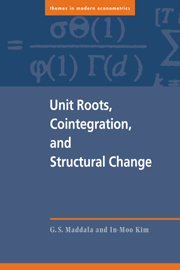Book contents
1 - Introduction
Published online by Cambridge University Press: 04 August 2010
Summary
During the last decade, the econometric literature on unit roots and cointegration has literally exploded. The statistical theory relating to the first order autoregressive processes where the autoregressive parameter is equal to one (unstable process) and greater than one (explosive process) was developed by Anderson (1959), White (1958, 1959), and Rao (1961) (see Puller (1985) for a review). However, the econometric literature on unit roots took off after the publication of the paper by Nelson and Plosser (1982) that argued that most macroeconomic series have unit roots and that this is important for the analysis of macroeconomic policies.
Similar is the story on cointegration. Yule (1926) suggested that regressions based on trending time series data can be spurious. This problem of spurious regressions was further pursued by Granger and Newbold (1974) and this also led to the development of the concept of cointegration (loosely speaking, lack of cointegration means spurious regression). Again, the pathbreaking paper by Granger (1981), first presented at a conference at the University of Florida in 1980, did not catch fire until about five years later, and now the literature on cointegration has exploded. As for historical antecedents, Hendry and Morgan (1989) argue that Prisch's concept of multicollinearity in 1934 can be viewed as a forerunner of the modern concept of cointegration.
The recent developments on unit roots and cointegration have changed the way time series analysis is conducted. Of course, the publication of the book by Box and Jenkins (1970) changed the methods of time series analysis, but the recent developments have formalized and made systematic the somewhat ad hoc methods in Box and Jenkins. Moreover, the asymptotic theory for these models has been developed.
- Type
- Chapter
- Information
- Unit Roots, Cointegration, and Structural Change , pp. 3 - 7Publisher: Cambridge University PressPrint publication year: 1999



